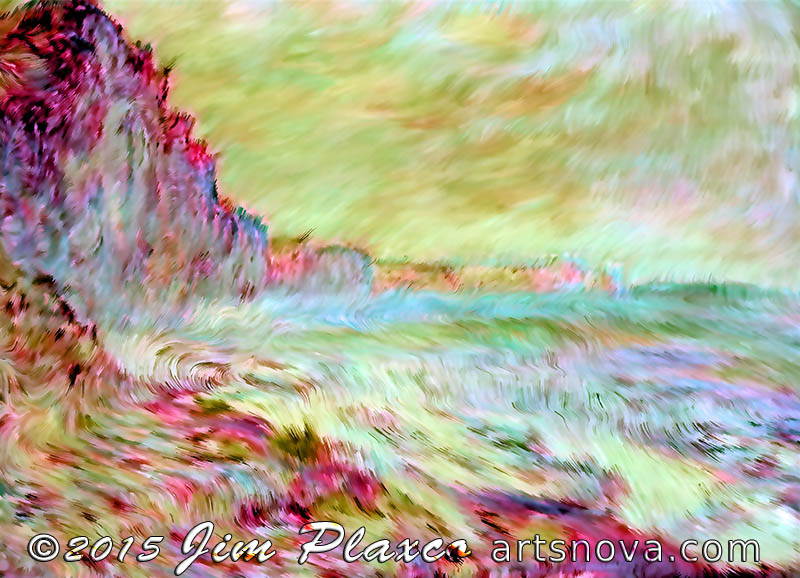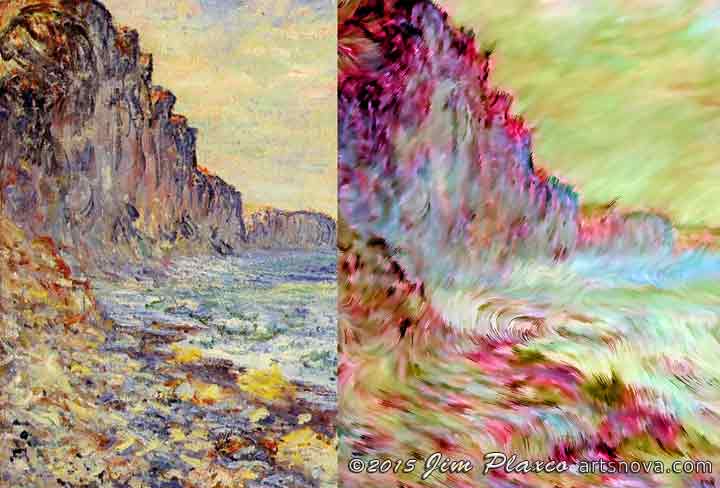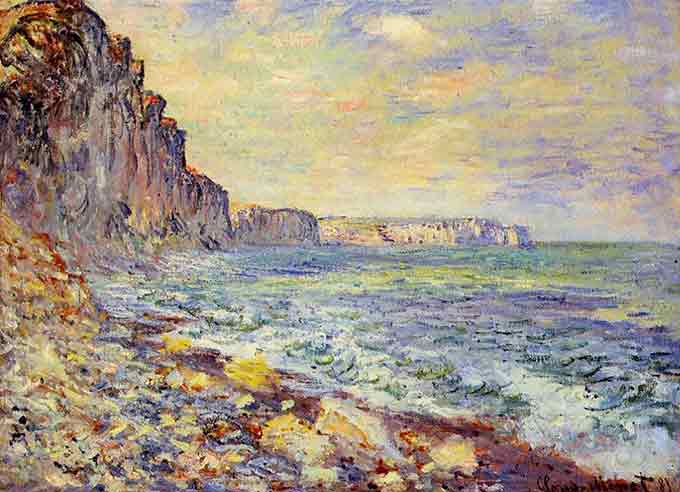Seaside Generative Art Rip-off

Monet Seaside Rip-off generative art
Monet Seaside Rip-off on Redbubble
Dare I say that I've gotten tired of looking at Mona Lisa, at least the digitized version. Just as the Playboy centerfold photograph of Lenna Șderberg became a standard image used by researchers in the field of image processing and just as the Utah Teapot became something of a standard test object for 3D graphics developers (modeling, lighting, texturing, rendering), images of the Mona Lisa have frequently been used as a test of generative art programs. I myself have created quite a few variations of the Mona Lisa Рsome of which may eventually see the light of day if I ever decide to make them public. But I thought it high time that I find a new work of art against which to test the generative painting programs which I greatly enjoy creating.
For this latest program I've been working on, I decided to make use of a painting by Claude Monet titled Morning by the Sea. This is not the first time I've used Monet's work. Some time ago I created a generative art video composed of paintings by Claude Monet (read about it at The Liquified Paintings of Claude Monet).
From my perspective, with respect to all generative art programs the designer faces the challenge of balance between artist control and program freedom/flexibility. In other words, how tightly or loosely do you want to hold the reins on the program? I view the question of control versus freedom as having two components.
First there is the ability of the artist to interact with the process. An example of a large degree of artist control would be that of a digital artist using an advanced brush in Adobe Photoshop. The Photoshop brush engine has a number of parameters available that make it possible for the artist to design a brush that can vary the way in which digital paint is applied to the canvas depending upon brush speed, pressure, direction. At the other extreme is what I'll call push-button painting. Again using Photoshop as an example, a photograph can be transformed into a non-photorealistic "painting" by simply applying one or more global filters to the photograph. A favorite exercise of mine is reverse engineering digital art that I see – not only figuring out what commercial software was used, but also determining what process was used.
The second aspect of freedom versus control is that of how the program itself is structured. Think determinism versus chaos. For example, let's say you have the following set of statements in a program:
int red = 256/2;
int green = 256/3;
int blue = 256/4;
color theColor = color(red,green,blue);
No matter how many times the above statements are executed, the color being created will always be the same color. In other words the system is deterministic. Now consider the following statements:
int red = (x % 255);
int green = (y % 255);
int blue = ( (x+y) % 255);
color theColor = color(red,green,blue);
Even though this code will result in a multitude of colors, it is still deterministic in that for any pair of x,y values, the color generated will always be the same. Lastly, there is this:
int red = random(256);
int green = random(256);
int blue = random(256);
color theColor = color(red,green,blue);
This represents a chaotic alternative where the color created could be anything. There is no control here. Any legal color is just as likely as any other legal color to be created.
These code examples are a gross over-simplification but serve to illustrate the challenge the developer faces. At one extreme everything is a foregone conclusion while at the other extreme it's anything goes. It is the designer's challenge to figure out where to put the fulcrum of their generative art system.
The generative painting program used to produce the artwork for this post has not one but two hearts (just like a Time Lord). The first heart is a flowfield object that consists of two separate, internal subsidiary flowfields. You can think of these flowfields as being the physics engines that drive the bristles of the paintbrush. These flowfields serve as forces of control in the system. The second heart is the particle system – which I define as a system of brush bristles, with each bristle having its own characteristics – within limits (again that freedom vs control issue).
For testing the program, I began by creating my own version of Monet's painting Morning By The Sea using Photoshop. The process was fairly straight forward. The lines of the painting are clear and the visual elements relatively simple. By digitally creating my own version of Monet's seaside landscape, I am now one step removed from the original. I can also go back and modify the art to see how those modifications affect the generative process.
The next step was to use my version of the painting as the color source for my generative painting program. I must confess that the first several "paintings" I created with the program weren't satisfactory but with each painting I would go back and modify the system.

left: Original Monet Morning By The Sea, right: generative version created from my modified version of Morning By The Sea
The version shown above is the first painting produced that I am sufficiently happy with to share. On the left is the actual painting and on the right is the version created using my generative painting program, which used as color input my own recreation of Monet's Morning By The Sea so you could call this a painting of a painting of a painting. I was sufficiently pleased with the results that I decided to make it available on Redbubble.
I plan to continue to work on my program as I'm still not really happy with the brushwork that my brush bristles are producing. A thought came to me last night in bed – that being to broaden the variety of bristles that I'm currently using with a focus being on the beginning and ending of each individual brush stroke. We'll see what happens.
About the Source Painting

The French painter Oscar-Claude Monet (1840-1926) was one of the founders of Impressionism and created a very large body of work over the course of his life. Monet completed Morning By The Sea in 1881. The image that I used as my reference source is from WikiArt.org and can be found on the WikiArt page for Claude Monet's painting Morning By The Sea.
| Return to the Blog Index | This entry was posted on Friday, August 14th, 2015 at 2:29 pm and is filed under Generative Art, New Media Art.